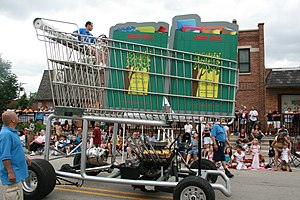- RT @MoneyMatters: Frugal teen buys house with 4-H winnings http://bit.ly/amVvkV #
- RT @MoneyNing: What You Need to Know About CSAs Before Joining: Getting the freshest produce available … http://bit.ly/dezbxu #
- RT @freefrombroke: Latest Money Hackers Carnival! http://bit.ly/davj5w #
- Geez. Kid just screamed like she'd been burned. She saw a woodtick. #
- "I can't sit on the couch. Ticks will come!" #
- RT @chrisguillebeau: U.S. Constitution: 4,543 words. Facebook's privacy policy: 5,830: http://nyti.ms/aphEW9 #
- RT @punchdebt: Why is it “okay” to be broke, but taboo to be rich? http://bit.ly/csJJaR #
- RT @ericabiz: New on erica.biz: How to Reach Executives at Large Corporations: Skip crappy "tech support"…read this: http://www.erica.biz/ #
The Magic Toilet

- Image by tokyofortwo via Flickr
My toilet is saving me $1200.
For a long time, my toilet ran. It was a nearly steady stream of money slipping down the drain. I knew that replacing the flapper was a quick job, but it was easy to ignore. If I wasn’t in the bathroom, I couldn’t hear it. If I was in the bathroom, I was otherwise occupied.
When I finally got sick of it, I started researching how to fix a running toilet because I had never done it before. I found the HydroRight Dual-Flush Converter. It’s the magical push-button, two-stage flusher. Yes, science fiction has taken over my bathroom. Or at least my toilet.
I bought the dual-flush converter, which replaces the flusher and the flapper. It has two buttons, which each use different amounts of water, depending on what you need it to do. I’m sure there’s a poop joke in there somewhere, but I’m pretending to have too much class to make it.
I also bought the matching fill valve. This lets you set how much water is allowed into the tank much better than just putting a brick in the tank. It’s a much faster fill and has a pressure nozzle that lies on the bottom of the tank. Every time you flush, it cleans the inside of the tank. Before I put it in, it had been at least 5 years since I had opened the tank. It was black. Two weeks later, it was white again. I wouldn’t want to eat off of it, or drink the water, but it was a definite improvement.
Installation would have been easier if the calcium buildup hadn’t welded the flush handle to the tank. That’s what reciprocating saws are for, though. That, and scaring my wife with the idea of replacing the toilet. Once the handle was off, it took 15 minutes to install.
“Wow”, you say? “Where’s the $1200”, you say? We’ve had this setup, which cost $35.42, since June 8th, 2010. It’s now September. That’s summer. We’ve watered both the lawn and the garden and our quarterly water bill has gone down $30, almost paying for the poo-gadget already. $30 X 4 = $120 per year, or $1200 over 10 years.
Yes, it will take a decade, but my toilet is saving me $1200.
Saturday Roundup
- Image via Wikipedia
This weekend, my wife is spending three days scrapbooking, which makes it a great time to visit my parents and let my niece and nephew entertain my girls for me.
Best Posts
Following your passion doesn’t always pay the bills. Sometimes, there is a tangent that can cover the mortgage while still allowing you to do what you love.
Not everyone enjoys it, but cooking isn’t hard. It’s not even a talent, but a skill that can be learned. Winging it, or creating your own dishes is a talent.
Did you know the spork’s predecessor was invented thousands of years ago?
Here’s a site to help you avoid conflicts with local customs when you travel.
Potluck game night. I think we need to make this happen at our house.
Carnivals I’ve Rocked
6 Ways to Stretch a Meal was an Editor’s Pick in this week’s Festival of Frugality. GenX Finance rocks.
Cheap Drugs – How I Saved $25 in 3 Minutes was included in the Carnival of Personal Finance.
Questions From a Reader was in the Carnival of Money Stories.
Thank you!
If I’ve missed anyone, please let me know.
Anchor Price Your Salary
- Image by Dalboz17 via Flickr
Conventional wisdom says that, when negotiating your salary or a raise, you should make whatever crazy ninja maneuvers it takes to get the other person to name a number first.
Horse pellets.
Have you ever watched an infomercial? Those masters of of impulse marketing geared towards insomniacs, invalids, and inebriates?
“How much would you pay for this fabulous meat tenderizer/eyelash waxer? $399? $299? No! If you call within the next 73 seconds, we will let you take this home for the low, low price of just $99.99!”
That’s the magic of anchor pricing.
The first number you hear is the number you will base all further numbers on. If you hear a high number, other lower numbers will feel much lower by comparison. The number doesn’t even have to be about money.
There was a study done that had the subjects compare a price to the last two digits of their social security numbers. Those with higher digits found higher prices to be acceptable, while those with lower prices only accepted cheaper prices.
What does an infomercial marketing ploy have to do with your salary?
If you are negotiating your salary and your potential employer gives a lowball offer, every higher counteroffer after that will much, much higher than than it would otherwise. On the other hand, if you start with your “perfect” salary, they amount you will be happy to settle for won’t seem to be nearly as high to the employer. At the same time, you will be less likely to accept a lowball offer if you set your anchor price high.
For example, if you are looking to make $50,000:
The employer offers you $40,000. $60,000 seems too high by comparison, so you counter with $50,000, then compromise and settler for $45,000. Or, you could start at $60,000, making the employer feel that $40,000 is too low, so he counters with $45,000, leaving a compromise at $52,000. That’s a hypothetical $7,000 boost, just for bucking conventional wisdom and taking a cue from the marketing industry.
How have you negotiated your salary?
How to Prioritize Your Spending
Don’t buy that.
At least take a few moments to decide if it’s really worth buying.
Too often, people go on auto-pilot and buy whatever catches their attention for a few moments. The end-caps at the store? Oh, boy, that’s impossible to resist. Everybody needs a 1000 pack of ShamWow’s, right? Who could live without a extra pair of kevlar boxer shorts?
Before you put the new tchotke in your cart, ask yourself some questions to see if it’s worth getting.
1. Is it a need or a want? Is this something you could live without? Some things are necessary. Soap, shampoo, and food are essentials. You have to buy those. Other things, like movies, most of the clothes people buy, or electronic gadgets are almost always optional. If you don’t need it, it may be a good idea to leave it in the store.
2. Does it serve a purpose? I bought a vase once that I thought was pretty and could hold candy or something, but it’s done nothing but collect dust in the meantime. It’s purpose is nothing more than hiding part of a flat surface. Useless.
3. Will you actually use it? A few years ago, my wife an cleaned out her mother’s house. She’s a hoarder. We found at least 50 shopping bags full of clothes with the tags still attached. I know, you’re thinking that you’d never do that, because you’re not a hoarder, but people do it all the time. Have you ever bought a book that you haven’t gotten around to reading, or a movie that went on the shelf, still wrapped in plastic? Do you own a treadmill that’s only being used to hang clothes, or a home liposuction machine that is not being used to make soap?
3. Is it a fad? Beanie babies, iPads, BetaMax, and bike helmets. All garbage that takes the world by storm for a few years then fades, leaving the distributors rich and the customers embarrassed.
4. Is it something you’re considering just to keep up with the Joneses? If you’re only buying it to compete with your neighbors, don’t buy it. You don’t need a Lexus, a Rolex, or that replacement kidney. Just put it back on the shelf and go home with your money. Chances are, your neighbors are only buying stuff so they can compete with you. It’s a vicious cycle. Break it.
5. Do you really, really want it? Sometimes, no matter how worthless something might be, whether it’s a fad, or a dust-collecting knick-knack, or an outfit you’ll never wear, you just want it more than you want your next breath of air. That’s ok. A bit disturbing, but ok. If you are meeting all of your other needs, it’s fine to indulge yourself on occasion.
How do you prioritize spending if you’re thinking about buying something questionable?
Rental Property Update
As I’ve mentioned before, we are fixing up the house we inherited in April to rent it out.
We already have renters lined up starting in February. My wife has known the couple for several years, so we’re not worried about strangers wrecking the place. We will be doing a lease, because skipping that is dumb, even if you know the tenants. They will be paying $1200 per month, plus electric, water, and garbage. We’ll be covering gas and–of course–property taxes. We’re paying the gas bill because we’re going to have most of the appliances on the repair plan through the gas company so we won’t have to worry about appliances breaking.
Those expenses will run about $325 per month, leaving $875 as profit. We’ll probably save another $200 of that to cover future vacancies and for property issues that I’m not foreseeing, leaving $675 to save and invest.
Over the summer, we have spent quite a bit of money fixing the place up.
- Dumpsters x3, $1200. Did I mention my mother-in-law was a hoarder?
- New boiler, $4500.
- Electrical repair, including running power to the garage, $1400.
- Plumbing & gas repair, $900.
- New stove & refrigerator, $1000.
- Landscaping, $2500.
- Other repairs, $8000.
So far, we have spent about $19,500 fixing this place up. There is still a bit of work left to do.
Are we done?
Crap, no.
- We have two rooms of stuff that we need to research and price individually before we sell. This includes some old cameras, typewriters, and collectibles.
- We need to buff and polish the hardwood floors that are in surprisingly good shape.
- We have to scrub the entire house. Cobwebs and mouse crap show up in interesting places when 90% of your house is buried for most of 30 years.
- We have to clean the last of the debris out of the basement. This, and some other stuff, will mean yet another dumpster.
- We have to paint walls and ceilings all over the house and the basement floor.
The to-do list will come with a price tag somewhere between $1000 and $1500.
That comes out to about $21,000 spent to make $675 per month. In just 3 years, the property will be turning a profit, then it becomes an actual profit center for us, hopefully forever. The expenses are all tax deductible, but only as depreciation, which means the cost has to get deducted a bit at a time over the course of the next 5 to 30 years.
On the other hand, we could probably sell the place for $200,000. It’s going to take 25 years of renting to make up that difference.


